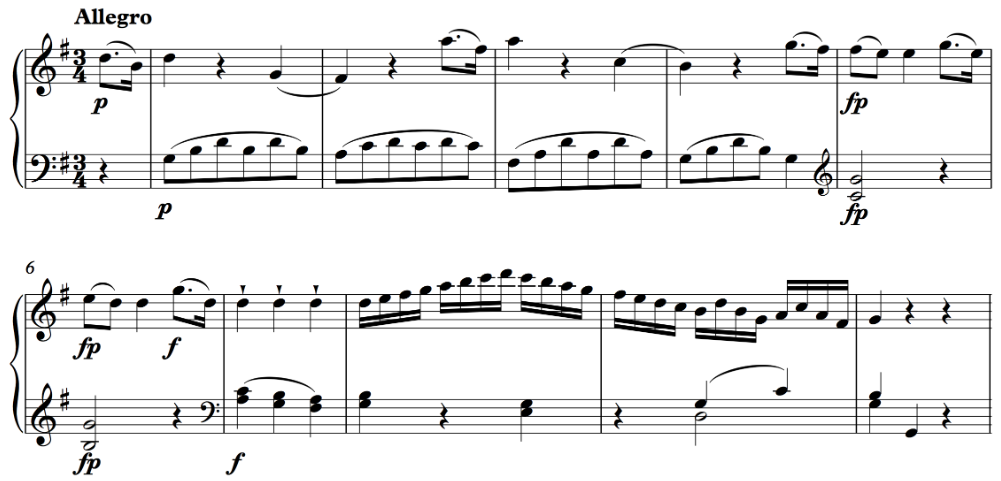4.1: Classical Theme Types - The Sentence
- Page ID
- 61965
The prototypical sentence is eight measures long and contains two four-measure phrases. The first of these is called the presentation phrase and the second is the continuation phrase.

Presentation phrase (mm. 1–4)
The presentation phrase begins the sentence and has two primary components, one melodic and the other harmonic. Melodically, it contains two repeated basic ideas (BI). Harmonically, it prolongs the tonic, by means of either a subsidiary harmonic progression or contrapuntal chords.

PRESENTATION: MOZART, K. 283, I., MM. 1–4
Here, the basic idea begins with the pickup to m. 1 and ends with the F-sharp on the downbeat of m. 2. It’s then repeated. Though a basic idea is often exactly repeated, this example shows that it need not be. Rather, a basic idea is defined more abstractly by its rhythm and melodic contour, and thus, varied repetitions like this are possible.
Harmonically, these four measures prolong tonic. Measures two and three are contrapuntal chords that are surrounded by the tonic:
I V4/3 V6/5 I
or
T(1 D(2 7)n 1)
Altogether, the two expressions of the basic idea and the tonic prolongation in this phrase exhibit presentation function. Hence, the name “presentation phrase.”
Continuation phrase (mm. 5–10)
Continuation phrases acquire momentum and lead to the cadence that ends the sentence. Three types of cadence typically end a sentence: PAC, IAC, or HC.
Continuation phrases begin with continuation function, which has one or more (but not necessarily all) of the following five characteristics.
- Fragmentation: a breakdown in the size of melodic units
- Liquidation: removal of “characteristic” melodic figures
- Sequential repetition
- Accelerated surface rhythm
- Accelerated harmonic rhythm

PRESENTATION + CONTINUATION: MOZART, K. 283, I, MM. 1–10
This example exhibits all five characteristics. The basic idea creates a normative unit that is two measures in length. Beginning with the pickup to m. 5, that normative size is fragmented into one-measure units whose second half is sequenced one step lower. At m. 7 increased surface rhythm is matched with an acceleration of harmonic rhythm as the pianist’s sixteenth notes occur above a hemiola in the pianist’s left hand.
Sentences always end with cadential progressions that support cadential function. In this passage, while mm. 5–8 prolonged tonic by means of contrapuntal chords, mm. 8–10 employ a typical cadential progression:
I IV6 Cad.6/4 V7 I
or
T1 S6 D5 — T1
And while mm. 5–8 employed fragments of the basic idea (the “characteristic” elements of the melody), mm. 8–10 liquidates those into elements unrelated to the basic idea (the “conventional” elements—scales and arpeggios, ending with a descending contour).
Phrase length
Note the length of the phrases in this example: a four-bar presentation phrase is followed by a six-bar continuation phrase. The prototypical phrase is four measures, but this is commonly expanded or even compressed by composers. In the sentence, continuation phrases are more likely to undergo expansions or contractions than are presentation phrases.


